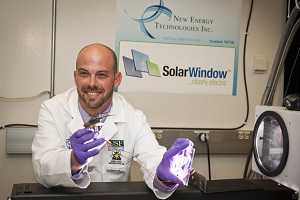New Energy moves closer to commercializing SolarWindow
 Many solar products in the early stages of development today seem downright futuristic. But, from solar roadways to solar windows, it’s all happening. And it’s working.
Many solar products in the early stages of development today seem downright futuristic. But, from solar roadways to solar windows, it’s all happening. And it’s working.
The U.S. Transportation Department is funding research into solar roadways, and New Energy Technologies announced two major breakthroughs with its SolarWindow technology within the last month.
Researchers last week successfully coated the glass surface of a working lab-scale prototype with newly-discovered organic electricity-generating coatings, comprised primarily of hydrogen and carbon, according to a release from the New Energy. The prototype was transparent and aesthetically pleasing.
Not long before that, New Energy researchers successfully applied the company’s spray-on solar technology to thin plastic sheets that could be applied to after-market glass the way window tinting is.
New Energy president John Conklin wrote in an e-mail interview that he has six product development goals for New Energy. They include a commercial window designed for sky-scrapers, structural glass for walls and tall structures, architectural glass that provides a decorative and functional purpose inside or out, residential window glass, film that can be adhered after-market and building components that transmit power from the solar windows into the buildings.
“Our recent breakthroughs are important initial development goals established in 2010 and early 2011,” Conklin wrote.
New Energy is still in the early stages of development and can’t even say yet what the efficiency of its solar photovoltaic products may be, Conklin said. That will be determined soon and verified by a third-party like the National Renewable Energy Laboratory in Golden, Colo.
But it’s just one of many steps on the path to commercializing what seems like a fanciful daydream. If any glass surface could generate energy—the windows in our house and the skylight on our car, the walls of glass on city sky-scrapers in cities across the world—the potential for energy production would become endless.
New Energy developed a working lab-scale prototype of its technology last week, and Conklin said there are many steps to commercialization, but they’re all laid out in front of him and are achievable. They include bolstering commercial protection for the company’s patents, pursuing commercial partnerships and additional funding, securing third-party verification of the SolarWindow module performance, and creating advanced models for how the windows would work as part of an entire building system.
“During the 2011 and 2012 operating years, we anticipate undertaking significant efforts to accelerate our SolarWidow toward commercialization,” Conklin wrote
Image courtesy of SolarWindow.



